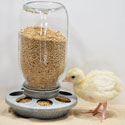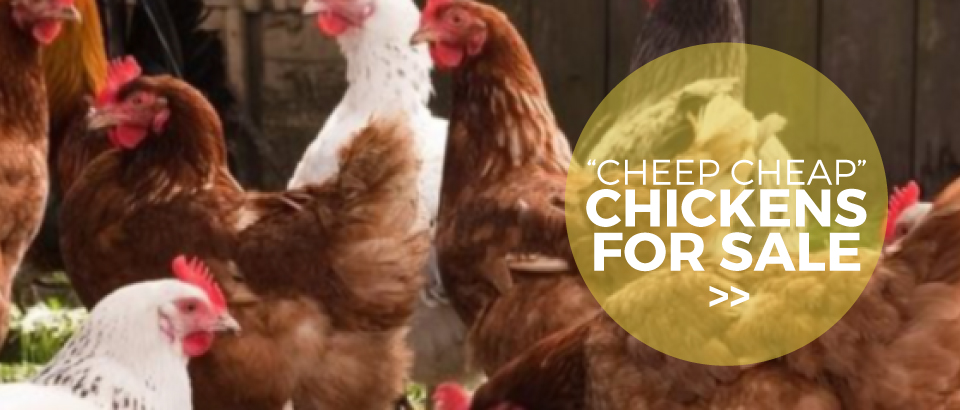
Newly hatched poultry come equipped with yolk reserves that provide baby birds with nutrients for many hours after they hatch. It’s nature’s way of allowing the early hatchers to remain in the nest until the whole brood has hatched. Hatchery chicks shipped by mail take advantage of these yolk reserves during the day or two they are in transit.
By the time chicks are delivered by mail, their yolk reserves are pretty well depleted. To help the chicks digest their first meal, first give them warm water to drink so they are well hydrated before they start eating. Feed them within 2 to 3 hours after they drink water.
Feed Options
The easiest way to ensure that chicks of all kinds get all the nutrients they need is to feed them a commercial starter ration, which contains a mixture of grains, protein, vitamins, and minerals. Starter is higher in protein and lower in calories than rations designed for older poultry. Never feed layer ration to baby chicks. The higher calcium content can seriously damage young kidneys.
If you are raising guinea keets, turkey poults, ducklings, or goslings, your local farm store may carry (or be willing to order) rations specific to their needs. Turkey starter contains more protein than chick starter and is suitable for keets and waterfowl as well. Where turkey starter is not available, game-bird starter is a good alternative. Mashed hard-boiled or scrambled egg makes an excellent starter ration for all types of poultry.
Some brands of chick, turkey, and game bird starter are medicated to prevent coccidiosis. If you are raising chicks for the first time, using medicated starter gives you one less thing to worry about while you work through your learning curve. However, medicated feed that is not formulated specifically for waterfowl should not be fed to ducklings and goslings, both because they do not need the same medications as land fowl and because they do not eat the same quantities of feed as land fowl and therefore may overdose on a medication not intended for them.
If the only available starter ration is one that has been formulated for land fowl, you may use it for ducklings and goslings provided you add a niacin supplement. The easiest way to prevent niacin deficiency in waterfowl is to add 8 ounces of brewer’s yeast to each 10 pounds of chick starter. Brewer’s yeast is available at supermarkets and health-food stores, although livestock-grade brewer’s yeast from a farm store is cheaper.
Continue feeding starter ration to your babies until they are nearly old enough to lay eggs, at which time they will need a layer ration. The main feed changes that occur as chicks grow are the increasingly greater amounts they eat and the type of feeder used.
Chick Feeders
Almost immediately on being placed in a brooder chicks look for things to peck. To help them find something to peck, sprinkle a little starter on a paper plate or a paper towel. Once they eat up all of that starter, they’ll look around for more and will find the chick feeder.
Chick feeders are designed to keep feed sanitary by preventing chicks from walking in it, sleeping in it, scratching in it, and pooping in it. For the first couple of weeks a round feeder base that screws onto a narrow mouth pint or quart size mason jar works well and takes up little brooder space. Another inexpensive option is a one-quart combination plastic feed holder and base. Chicks of all species quickly outgrow their first feeders. They will begin to eat more, emptying the feeder too quickly. Their heads will grow too big to fit into the chick feeder design. And they will start roosting on top of the feeder, making a mess below.
At this point they will need a feeder with a larger capacity and larger base. An adjustable height hanging feeder is ideal for this purpose. As chicks grow larger, the height of the feeder may be easily adjusted to the same height as the birds’ backs, resulting in minimal waste of feed. This style of feeder also has a roosting guard to keep chicks from perching on top.
Whenever you change to a different feeder, leave the old one in place for a few days until you’re sure all the chicks are eating from the new one. Keep your chicks well supplied with a nutritious starter ration and they will reward you by being healthy and growing well.
And that’s today’s news from the Cackle Coop.
Gail Damerow, author, Hatching and Brooding Your Own Chicks (Chickens, Turkeys, Ducks, Geese, Guinea Fowl)



Can you ship C.O.D. anywhere in Alaska?
We do not ship cash on delivery but do ship to Alaska